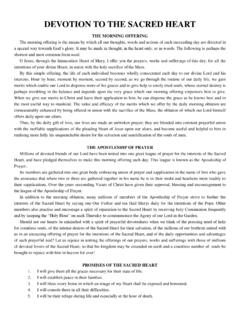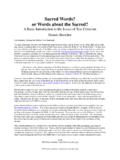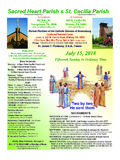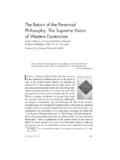Transcription of Summary of Sacrosanctum Concilium The …
1 Summary of Sacrosanctum Concilium The constitution on the sacred Liturgy By: Deacon Ed Sheffer The very first line of Sacrosanctum Concilium quantifies the main goals of the Council: reinvigorate Catholics, modernize the Church in a meaningful way, promote unity of all Christian denominations, and reach out to the whole world. This document reveals that God s love created a perfect way for us to worship God by a divine means, all for our good. If we know what true liturgy is and participate fully in it, liturgy allows us to be drawn closely to God s love.
2 Liturgy is a means of seeking and finding perfect truth and love. Participating in liturgy is a response to Christ s presence in his Church. Liturgy is the official worship of the Church. Liturgy consists of the Seven Sacraments and the Liturgy of the Hours. Chapter One: Priniciples The Mass is referred to as The sacred Liturgy. The Mass allows us to participate in the Paschal Mystery of Christ s Passion, Death, Resurrection, and Ascension, for Christ is present in Liturgy. Christ s love flows to us in a special way from the Eucharist and The Word of God. Additionally, Christ is present to us in the priesthood, diaconate, and in the people of God.
3 Through baptism we are called to actively share in Liturgy. Liturgical services are never private in nature. Liturgy is a Celebration of the Church, and it signifies our unity in Christ! There is never to be random modification to Liturgy without the consent of the Holy See. The bishop of a diocese is the one who leads the diocese liturgically. He is meant to ensure that liturgy conforms to the approved norms set in place by the Vatican and laid down by him. Although private prayers and devotions are meaningful, the sacred Liturgy is The Source and Summit of life: the beginning and the end of who we are and who we can become.
4 Chapter Two: The Eucharist The Eucharist Celebration is to foster more profound love of God as well as love for each other. The constitution on the sacred Liturgy makes it clear that God s Word was to become a more dynamic part of liturgy. The Council ordered a change in the Sunday readings at Mass. They prescribed set readings over a three year cycle, so Catholics would become more familiar with the Bible. The homily provided at Mass is to reveal the eternal truth of the Gospel. The Liturgy of the Word and the Liturgy of the Eucharist form a single act of worship, because they both provide the living presence of Christ.
5 They are not separate from one another. Chapter Three: Other Sacraments and Sacramentals The Council Fathers proposed the restoration of the Catechumenate for Adults. A time was to be set aside for formation and instruction. The Rite of Confirmation was to be revised, making the strong connection with Baptism clearer. The Sacrament of Extreme Unction received a more modern name: Anointing of the Sick. It was made clear that this Sacrament was to be reserved for those near death. The purpose of the Sacraments is threefold: give worship to God, build up the Body of Christ, and sanctify humanity. Chapter Four: Divine Office The Divine Office (Liturgy of the Hours), is a sacred prayer, meant to help us remember that every day, every hour, and every minute are holy.
6 To promote this, certain times of the day are set aside for God to be officially praised throughout the day. The Office is an ancient tradition and prized possession, which unites the Church to God. To pray the Office is an honor and a duty of the ordained, given to them to praise God on behalf of the entire Church. However, all people are encouraged to pray it (most religious communities do). It is a requirement for all priests and deacons to do so. The premise for the prayer is rooted in Scripture: without prayer we can do nothing. The Divine Office is an official liturgy in and of itself. Lauds (Morning Prayer) and Vespers (Evening Prayer) are the chief hours to be celebrated.
7 The Divine Office is the public prayer of the Church. It is a powerful source to help one remain faithful and be fed. Chapter Five: Liturgical Year The Church regards the whole mystery of Christ as important and this is why it is formed as a Liturgical Year. It is a set calendar commemorating and recalling the mysteries of redemption. The three year liturgical cycle is meant to celebrate the fuller story of Jesus, from birth and life, to death and resurrection, to ascension and the promise of his return. The purpose of a liturgical calendar is about centering people on Christ. Chapters Six & Seven: Music and Art The Council Fathers said that all music and art incorporated into the liturgy should be committed to directing minds to see God prayerfully.
8 They should promote faithfulness and lift hearts to want to pray and be one with God. Church structures to be constructed are to be designed specifically with liturgy in mind. The design inside should be laid out is such a way that it helps promote active participation. Conclusion On February 16, 1964, the first Sunday of Lent, the decrees of the constitution on sacred Liturgy went into effect. Vatican II stipulated that it was necessary for liturgical reform to give the clergy a new look. It had become evident that it was necessary to add more structure and hold priests accountable to adhering to prescribed norms.
9 Comments I think we realize that the word Catholic means Universal. The Church is to be universal in the sense that the Church belongs to Christ and all should have access to him. The Church is to provide glory to God the Father. This is one of the main reasons Jesus set it into motion. The word Eucharist means thanksgiving. The Eucharistic Celebration is a sacrament of thanksgiving. Thanksgiving for the love revealed in the mysteries celebrated at Mass in God s Word and in Jesus Suffering, Death, Resurrection, and Ascension. Thanksgiving for the very mystical way he still loves us, as he comes to us and is literally present in the consecrated host.
10 The nourishment we receive from the Eucharist and God s Word should have a profound effect on the way we live our life. If we honestly encounter Christ in the Eucharist, it causes us to become someone more authentic. There is a strong connection to God s holiness through liturgy and when we come together and truly celebrate liturgy, our commonness in need of God does have a profoundly unifying effect. Recent studies show the most frequent explanation offered by former Catholics who have joined other churches is they left because they didn t feel like they were getting the spiritual nourishment they desired in the Catholic Church.








